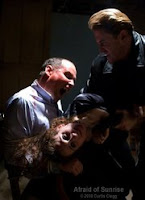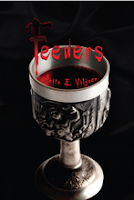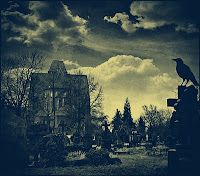



All photos: Curtis Clegg
Actor / Part
Tom Lodewyck - Senator Neil Oldman (the man who turns into the the vampire)
Deneen Melody - Ryder, Vampire Hunter (Blonde in the red dress)
Elana Cohn - Prostitute (girl that gets bitten)
Director, Producer: Justin R. Romine Director of Photography: Don Ford
Script: Andy SchatnerJustin R. Romine graciously answered my questions about his up coming film, “Afraid of Sunrise”. I wanted to better understand what he was trying to do, and hope to do with the short version. When they are finished with it they will be taking it around to many film festivals around the country. “The more people that see it, the better chance we'll have at selling it, or the idea of the feature,” Romine told me in a chat over at facebook.
Here are more of my questions and his very detailed answers. It's wonderful to get to know a little bit more about a subject I know so little about—film making.
Lorelei: I understand that you are going back to a more graphic style of vampire film. What known film can you name that would be similar in what
you are trying to accomplish?
Justin: That's a very hard question to answer honestly. I don't think that what we're doing has been done before. I'm mixing my influences from a myriad of sources and genres. My director of photography, Don Ford, and I are reflecting on our favorite film styles and weaving them creatively into the film. For example, we are using themes and elements from the Spaghetti Western when introducing some of our characters. When we are first introduced to Ryder we beckon back to the Western. We also are shooting and lighting the film in a film noir style in which we utilize shadows as well as darkness into our film. We also have the idea of the femme fatal in Ryder. Another piece of magic we've been able to pay homage to is the films of Stanley Kubrick. We've done an amazing job of doing a hallway shot in the hotel that reflects the seminal film The Shining. I'm really trying to incorporate a multitude of styles into my film in the hopes to making something that will stand on its own. I'm kicking back to the old horror films made in the 40s that weaved elements from other films into their projects.
Lorelei: Is there a darker, or underlying message in the movie you're trying to bring out?
Justin: There is a real message in the film as well that mirrors the police state and government control in which we live in. You'd have to talk to Andy Schatner more about that as we wrote the script.
Lorelei: How many actors do you have working on the film?
Justin: All together we will probably end up with over 50 actors working on this film. We have a main cast of about 10-15 and we have an extra cast ranging from anywhere between 30-100 people depending how many people we get to show up to our extra casting call.
Lorelei: Is this something you've wanted to do for a while, this type of film? A vampire movie?
Justin: I have been interested in making a vampire film since I was a child around the age of 8. I used to watch the old Dracula movies and became obsessed with the Nosferatu darker edge to the stories. Nothing scared me more than those OLD movies Dracula, Wolfman, Frankenstein.
Lorelei: Cool. How long did it take to pare down the major film script to where you wanted it for this one? Was that difficult?
Justin: So far we haven't had to cut anything from the script except a couple lines of dialog. This script is based on a full length feature script called "Afraid of Sunlight" in which Andy wrote as well. The short film we're making is a fraction of what goes on in the feature script. Different characters, settings, and stories all fill the feature script which we hope to find funding through Afraid of Sunrise to make. It'll be a much bigger budgeted film.
Lorelei: I understand that it will take you until about January to have this film finished. How long do you estimate the full-length one will take?
Justin: Making a full-length feature, especially a funded one, will be made a lot quicker believe it or not. When you have a nice sized budget where you're paying people to be on set, people work more efficiently because it's employment. We're paying them to be there, it's a job. That being said, if we're paying people, like actors, we pick the best ones available to shoot. Since it's a paying job we have the power to schedule consecutive shoot dates. If you get the film shot quicker you can move on to post-production. When you're making a low budget film, you have to work around people's schedules and that seems to spread out a shoot some.
Lorelei: Will you be able to use the same actors?
Justin: Some of the same actors will probably be invited to audition for the roles first and foremost. Some of the actors may be replaced with bigger named actor, that's just how the business works. Actually some of the actors do not even show up in the feature film. A couple of the actors caught wind late of our casting but we were ecstatic to have them interested so we wrote them parts.
Lorelei: When did you first decide that you wanted to become a director?
Justin: I've wanted to make films since I started becoming mesmerized by the magic of movies. I have always been an imaginative person. I used to act out plays and movie scenes in my bedroom. I would play all of the characters and sometimes I'd even video tape them. Thankfully non of them exist anymore.
Lorelei: Where did you go for schooling?
Justin: I graduated with my Bachelor of Arts in Film from The University of Nevada, Las Vegas. I also have many years of technical experience and training in the television production business.
Lorelei: What do you like most about directing a movie such as this one?
Justin: I love meeting new people, bonding with them, and creating something magical. I love working with the actors. Sometimes directors and actors
talk about very private things when discussing how to approach their roles. I feel like a mentor, giving my spin on things, and ultimately letting them push themselves as actors.
Lorelei: What is the hardest part, or something you don't enjoy?
Justin: Sometimes time director has to be the bad guy. Sometimes we're forced to put people into uncomfortable position, working long late hours. Also,it's my job to make sure everything is professional on the set and everybody knows what they're doing. You have to keep things moving or scenes will take forever to get shot. You have to keep the crew moving quickly, yet efficiently.
Lorelei: How did you come to choose some of the places for filming, like the Stratford Inn? How did that come about? Did someone suggest it?
Justin: Photographer Curtis Clegg first suggested the Stratford. He lives in Sycamore and is familiar with the hotel. We were in the process of setting up another place to shoot, but we thought we'd give it a try. The Stratford was extremely accommodating and excited to have us there. Really cool locations can add production value to your film. We like using unique places so they can be a character in the film as well as a location.
Lorelei: Where are you at in production now, or where are you filming?
Justin: We're shooting again on Sunday and after that we have a handful more scenes to shoot and we'll e done. I'd say after Sunday's shoot, we'll be about half done with shooting. Again, we're working on many schedules so our shoots are spread throughout October and probably a week or two into November.
Lorelei: Is there anything you'd like to add that I may not have thought to ask about?
Justin: This film has been funded entirely through donations. We allow people to contribute as little as 5 bucks. We offered many perks for the donations too. We offer a chance to be an extra or to even be in a scene with Deneen Melody. We'll be giving away autographed scripts, photos, and props.
We are now raising money for post production (editing, sound, ect). We are giving away one of a kind props with donations as well T shirts and dvds. People can check out how they can be involved by going to our IndieGoGo page here:http://www.indiegogo.com/afraidofsunrise?i=piteThey can also see the short teaser trailer we put together of the footage we've already shot.
Also if any one wants to check out his site:
www.fatheadfilms.netJustin tells me that they are hoping to show this film at many film festivals, not just one. "The more people that see it the better chance we'll have at selling it, or the idea of the feature."
Also he hopes to show it at local theaters. I know I'll want to go and see it!



















